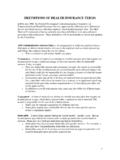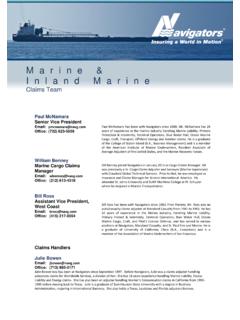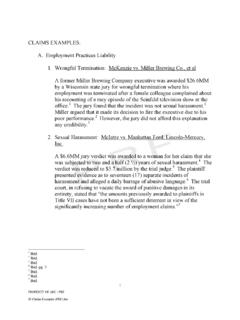Transcription of Shared services in life insurance - EY - United States
1 Financial services insurance Shared services in life insurance Creating highly efficient and cost-effective operations centers By Frank Memmo Jr. and Nancy Conturso Historically, life insurance companies have not been early or aggressive adopters of Shared services in operations. As banks, manufacturers and companies in a wide range of industries embraced Shared services to centralize, standardize and reduce the costs of various back-office functions, life insurers largely remained on the sidelines. This lagging adoption by life insurers was mostly a result of the perception that individual product lines and business units (BUs) had such unique processing, support and technology needs that their back offices had to remain independent of those supporting other product sets.
2 Today, however, this conventional wisdom is changing as the business case for Shared services has become clearer and more compelling. With current economic conditions forcing a re-evaluation of existing services centers are notable for their customer focus, critical mass of operational models and cost structures, Shared services is a viable process expertise, high service levels, objective quality measures and option to streamline processes, set the foundation for long-term widespread use of enabling technologies. operational excellence and increase long-term profitability. The While Shared services has a well-earned reputation for reducing strongest Shared services value proposition in life insurance involves costs, life insurers have long feared that standardized processes the creation of highly efficient and cost-effective operations centers would compromise their ability to deliver quality service to high- that go beyond simple accounting and HR processes to support value customers or to tailor the customer experience by product.
3 Underwriting, policy administration, claims management and other Further, it was widely believed that the needs and preferences of core business functions across the product portfolio. group life customers, for example, were so different from those of This paper will explore the critical questions and challenges life individual annuity customers that there was no way to manage even insurers must address as they seek to optimize core operational simple administrative tasks ( , address changes) through a single, processes in Shared services . Further, it will highlight the best-in- centralized group. Because those lines of business also maintained practice first steps to take in the Shared services journey. their own profit and loss statements and unique go-to-market approaches, executive leadership was understandably reluctant to Common challenges, shifting perceptions and new give up control of any operation or process with an impact on bottom- opportunities line performance.
4 The concern over control was demonstrated by a preference for a direct-reporting management approach and a direct We define Shared services as operations centers that support multiple line of sight into service delivery. product entities or lines of business and use common practices and procedures to ensure standardization and efficiency in specific One downside of this product-centric or BU-led management approach processes, such as claims or billing. Typically, these operations is the siloed organizations, processes and systems that have developed centers now are internally staffed, although some resources may be at many insurance companies. Decades of acquisitions and growth have outsourced. While many companies initially apply Shared services also contributed to this organizational structure.
5 In some cases, carriers operating models to accounting, finance, HR or IT, forward-looking have duplicative functions, with different teams handling the same basic insurers are also moving other operations, such as claims, billing, work and activities at varying levels of competency and performance. underwriting and policy administration processes, to Shared To be clear, Shared services is not exclusively about cutting costs. services models. Operations centers allow organizations to generate It can also help life insurers manage a range of other challenges, significant value through consolidation and standardization while including compliance with the increasingly complex regulatory focusing specific capabilities and resources on the unique needs of changes underway in the US and abroad.
6 New regulations demand individual product sets or lines of business. Top-performing Shared a more rigorous, automated and repeatable approach to managing FIGURE 1: In deploying Shared services , life insurers may explore a range of operational models to balance their needs for control and customization versus standardization. High Center of excellence Corporate/regional office Aggregates activities that require specialized Aggregates strategic and governing activities Complexity of transactions knowledge or expertise Is decision-/action-intensive Is issue/knowledge-intensive Calls for relative proximity to business Is organized often by region Shared service center Local office Consolidates organization Has activities distributed for local service needs Enables operational focus Requires manual or end user intensive activities Is established to streamline, scale and centrally Critically needs local knowledge perform routine transaction-based activities Low Low High Need for control/proximity to business 2.
7 Risk, capturing the required data and delivering on multiple, complex reporting requirements. Current systems and processes greatly Lessons learned constrain insurers' compliance efforts, forcing them into inefficient, costly and error-prone manual workarounds to deliver the required Insurers who have leveraged Shared services to reduce costs and reports. With a higher degree of automation and efficiency, Shared improve performance point to the following lessons learned as services centers can greatly streamline the process of regulatory keys to success. reporting and mitigate the risk of non-compliance. Leadership commitment. Because the creation of operations Collectively, these factors underscore why life insurers need to take centers can affect multiple functions and business units, senior the long view and consider strategic approaches to establishing a leaders must establish and promote the vision, make the case flexible and lower-cost operating structure suitable for the ongoing for change, and provide visible support and advocacy before and evolution of product portfolios and continuous improvement of during implementation.
8 Processes. Centralizing core support, administrative and transaction Shared services or operations centers as a separate business. processing capabilities in a Shared services organization or a Treating a Shared services center as a business can help drive dedicated operations center represents such a strategy. operational excellence, provided that metrics and SLAs are clearly defined and enforced. For captive Shared services centers, The business case for Shared services the management team running the site on a day-to-day basis Cost savings are a key driver of the Shared services value proposition. must have the skills and motivation to lead the change and shape Our experience suggests that total net savings typically range from a high-performance culture.
9 15% to 40% from initial, pre-implementation baselines. Of course, Clear targets and accountability. The strongest business cases start-up costs for developing the centralized operations center must for Shared services feature quantifiable ROI projections and be accounted for in preliminary return on investment (ROI) models. specific performance targets. Further, process and performance Several factors contribute to the overall savings, starting with lower owners should be identified to ensure suitable support and labor costs. The reduction of duplicate resources, labor arbitrage oversight are given to the new operating model. in offshore locations, economies of scale and process automation Standardization of processes prior to implementation of can produce a 25% to 35% decrease in the labor cost component of Shared services .
10 Experience shows that standardizing processes baseline expenses. Process simplification with the goal of enhancing before moving to centralized operational models is advantageous efficiency and effectiveness can result in additional savings of 5% to to generating sooner-than-expected cost reductions and 8% of overall baseline costs. Consolidation of similar work activities performance gains. The re-engineering process can uncover in fewer locations can deliver baseline cost reductions of 3% to 5% as common needs that are a good fit for centralization, as well as well. Further, minimizing redundant infrastructure by consolidating those sub-tasks that require customization for each product line and rationalizing systems helps cut technology budgets.
















